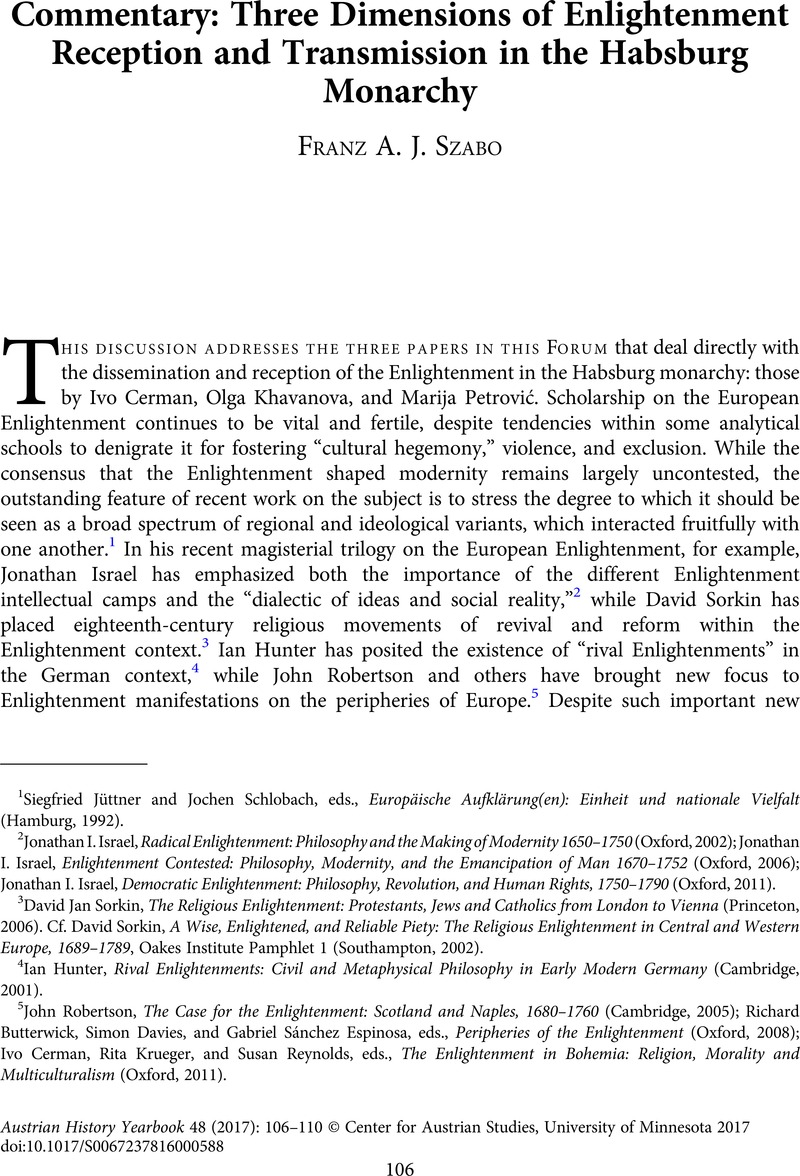No CrossRef data available.
Published online by Cambridge University Press: 20 April 2017

1 Jüttner, Siegfried and Schlobach, Jochen, eds., Europäische Aufklärung(en): Einheit und nationale Vielfalt (Hamburg, 1992)Google Scholar.
2 Israel, Jonathan I., Radical Enlightenment: Philosophy and the Making of Modernity 1650–1750 (Oxford, 2002)Google Scholar; Israel, Jonathan I., Enlightenment Contested: Philosophy, Modernity, and the Emancipation of Man 1670–1752 (Oxford, 2006)CrossRefGoogle Scholar; Israel, Jonathan I., Democratic Enlightenment: Philosophy, Revolution, and Human Rights, 1750–1790 (Oxford, 2011)Google Scholar.
3 Sorkin, David Jan, The Religious Enlightenment: Protestants, Jews and Catholics from London to Vienna (Princeton, 2006)Google Scholar. Cf. Sorkin, David, A Wise, Enlightened, and Reliable Piety: The Religious Enlightenment in Central and Western Europe, 1689–1789, Oakes Institute Pamphlet 1 (Southampton, 2002)Google Scholar.
4 Hunter, Ian, Rival Enlightenments: Civil and Metaphysical Philosophy in Early Modern Germany (Cambridge, 2001)CrossRefGoogle Scholar.
5 Robertson, John, The Case for the Enlightenment: Scotland and Naples, 1680–1760 (Cambridge, 2005)CrossRefGoogle Scholar; Butterwick, Richard, Davies, Simon, and Espinosa, Gabriel Sánchez, eds., Peripheries of the Enlightenment (Oxford, 2008)Google Scholar; Cerman, Ivo, Krueger, Rita, and Reynolds, Susan, eds., The Enlightenment in Bohemia: Religion, Morality and Multiculturalism (Oxford, 2011)Google Scholar.
6 The essays in Robertson, Ritchie and Timms, Edward, The Austrian Enlightenment and Its Aftermath (Edinburgh, 1991)Google Scholar focus less on the classic era of the Enlightenment in the Habsburg monarchy (1750–92) and more on its aftermath (1792–1848).
7 Klingenstein, Grete, “The Meanings of ‘Austria’ and ‘Austrian’ in the Eighteenth Century,” in Royal and Republican Sovereignty in Early Modern Europe: Essays in Memory of Ragnhild Hatton, eds. Oresko, Robert, Gibbs, G. C., and Scott, Hamish (Cambridge, 1997), 423–78Google Scholar.
8 Evans, R. J. W., “The Origins of Enlightenment in the Habsburg Lands,” in Austria, Hungary, and the Habsburgs: Essays on Central Europe, c. 1683–1867 (Oxford and New York, 2006), 36–55 Google Scholar.
9 The standard work remains Bodi, Leslie, Tauwetter in Wien: Zur Prosa der österreichischen Aufklärung, 1781–1795, 2nd ed. (Vienna, 1995)CrossRefGoogle Scholar, with a full bibliography (including a supplementary bibliography in the second edition).
10 The most important study of this development is Wangermann, Ernst, Die Waffen der Publizität: Zum Funktionswandel der politischen Literatur unter Joseph II (Vienna, 2004)Google Scholar.
11 Winter, Eduard, Der Josephinismus und seine Geschichte: Beiträge zur Geistesgeschichte des österreichischen Reformkatholizismus, 1740–1848 (Brno, 1943)Google Scholar, second edition under the title Der Josephinismus: Die Geschichte des österreichischen Reformkatholizismus, 1740–1848 (Berlin, 1962); Valjavec, Fritz, Der Josephismus: Zur geistigen Entwicklung Österreichs im 18. und 19. Jahrhundert (Brno, 1944)Google Scholar; Maaß, Ferdinand, ed., Der Josephinismus: Quellen zur seiner Geschichte in Österreich, 1760–1790, 5 vols., Fontes Rerum Austriacarum II, vol. 71–73 (Vienna, 1951–56)Google Scholar. A detailed bibliography of this literature to the early 1980s is in Plaschka, Richard Georg, Klingenstein, Grete, et al. , eds., Österreich im Europa der Aufklärung: Kontinuität und Zäsur in Europe zur Zeit Maria Theresias und Josephs II, vol. 2 (Vienna, 1985), 1023–31Google Scholar. Most recently, see Wolfgang Schmale, Renate Zedinger, and Jean Mondot, eds., Josephinismus—Eine Bilanz/Échecs et réussites du Joséphisme, Jahrbuch der Österreichische Gesellschaft zur Erforschung des 18. Jahrhunderts 22 (Bochum, 2008); and Franz L. Fillafer and Thomas Wallnig, eds., Josephinismus zwischen den Regimen. Eduard Winter, Fritz Valjavec und die zentraleuropäischen Historiographien im 20. Jahrhundert, Schriftenreihe der Österreichischen Gesellschaft zur Erforschung des 18. Jahrhunderts 17 (Vienna, 2016).
12 Schwicker, J. H., Politische Geschichte der Serben in Ungarn (Budapest, 1880), 99–118, 310–33, 358–403 Google Scholar.
13 Cerman, Ivo, Habsburgischer Adel und Aufklärung: Bildungsverhalten des Wiener Hofadels im 18. Jahrhundert (Stuttgart, 2010)Google Scholar.
14 Cerman, Ivo, “The Aristocratic Achievement: Aristocratic Writers and Philosophers in Bohemia,” Austrian History Yearbook 48 (2017): 39–53 CrossRefGoogle Scholar.
15 Osterloh, Karl-Heinz, Joseph von Sonnenfels und die österreichische Reformbewegung im Zeitalter des aufgeklärten Absolutismus (Lübek, 1970)Google Scholar; Reinalter, Helmut, ed., Joseph von Sonnenfels (Vienna, 1988)Google Scholar; and, most recently, Karstens, Simon, Lehrer, Schriftsteller, Staatsreformer: Die Karriere des Joseph von Sonnenfels (1733–1817) (Vienna, 2011)CrossRefGoogle Scholar.
16 Heindl, Waltraud, Gehorsame Rebellen: Bürokratie und Beamte in Österreich 1780 bis 1848 (Vienna, 1991)Google Scholar, see especially 103–15.
17 I want to draw special attention to the brilliant discussion of this problem by in, Grete Klingenstein “Riforma e crisi: La monarchia austriaca sotto Maria Teresa e Giuseppe II. Tentativo di una interpretazione,” in La dinamica statale austriaca nel XVIII e XIX secolo: Strutture e tendenze di storia constituzionale primo e dopo Maria Teresa, ed. Schiera, Pierangelo (Bologna 1981), 93–125 Google Scholar.
18 Khavanova, Olga, “Joseph von Sonnenfels's Courses and the Making of the Habsburg Bureaucracy,” Austrian History Yearbook 48 (2017): 54–73 CrossRefGoogle Scholar.
19 Ernst Wangermann has led the way with a number of stimulating essays touching on music: “Ethik und Ästhetik—Moralische Auflagen an die schönen Künste im Zeitalter der Aufklärung,” in Genie und Alltag: Bürgerliche Stadtkultur zur Mozartzeit, ed. Gunda Barth-Scalmani and Ernst Wangermann (Salzburg, 1994), 281–93; “‘Vom himmlischen Gewölbe/Ströhmt reine Harmonie/Zur Erde Hinab’—Aufgeklärte Religiosität im Unterricht und in den späten Oratorien Haydns,” in Und eine neue Welt entspringt auf Gottes Wort. Haydns und van Swietens späte Oratorien—Aspekte ihres geistigen Hintergrunds und musikalischen Tons, Österreichische Akademie der Wissenschaften, Philosophisch-historische Klasse, Sitzungsberichte 830, eds. Theophil Antonicek and Christian K. Fastl (Vienna, 2012), 21–32; “Wien und seine Kultur zur Zeit Glucks,” in Gluck Studien 1, ed. Gerhard Croll (Kassel, 1989), 13–20; “Revolution in Music—Music in Revolution,” in Revolution in History, ed. Roy Porter and Mikulás Teich (Cambridge 1986), 226–39. From the musicological side we have an excellent example in David Schroeder, Haydn and the Enlightenment (Oxford, 1990). For the visual arts cf. Waissenberger, Robert, “Aufklärung, Merkantilismus, Absolutismus und Klassizismus,” in Klassizismus in Wien: Architektur und Plastik, ed. Historisches Museum der Stadt Wien (Vienna, 1978), 9–21 Google Scholar; Wangermann, Ernst, “Maria Theresa—A Reforming Monarchy,” in The Courts of Europe 1400–1800, ed. Dickens, A. G. (London, 1977), 283–303 Google Scholar; Kaufmann, Thomas DaCosta, Painterly Enlightenment: The Art of Franz Anton Maulbertsch, 1724–1796 (Chapel Hill, 2005)Google Scholar; Hainisch, Erwin, Der Architekt Johann Ferdinand Hetzendorf von Hohenberg (Innsbruck, 1949)Google Scholar.
20 Vick, Brian F., The Congress of Vienna: Power and Politics after Napoleon (Cambridge, 2014)CrossRefGoogle Scholar.